The Crucial BX200 (480GB & 960GB) SSD Review: Crucial's First TLC NAND SSD
by Billy Tallis on November 3, 2015 9:00 AM ESTRandom Read Performance
Our random read performance test is conducted on a full drive and tests queue depths from 1 to 32. We focus primarily on the lower queue depths that are typical of interactive use, but also look at how the performance and power scales to more intensive loads. For desktop use, searching and virus scanning are typically the biggest sources of random reads, and they can exercise some of the larger queue depths. When working on a fragmented filesystem or with lots of small files, random I/O performance (especially for low queue depths) comes into play.
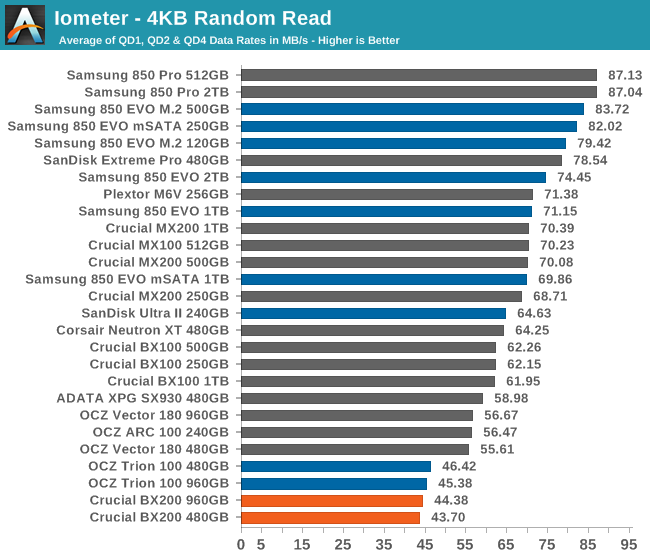
Random reads are slow, but at least the BX200 has company. This is what slow TLC flash does, but unlike many other results so far, this performance is not cause for major concern.
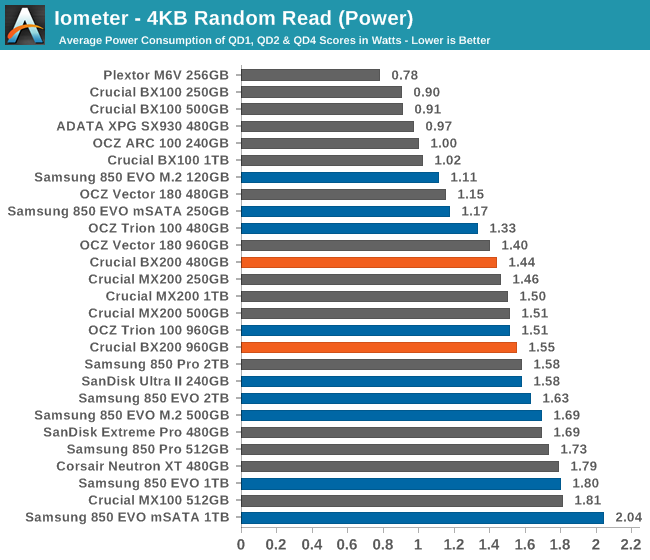
Power consumption is in the middle of the pack, so the BX200 is doing something (almost) right when handling reads.
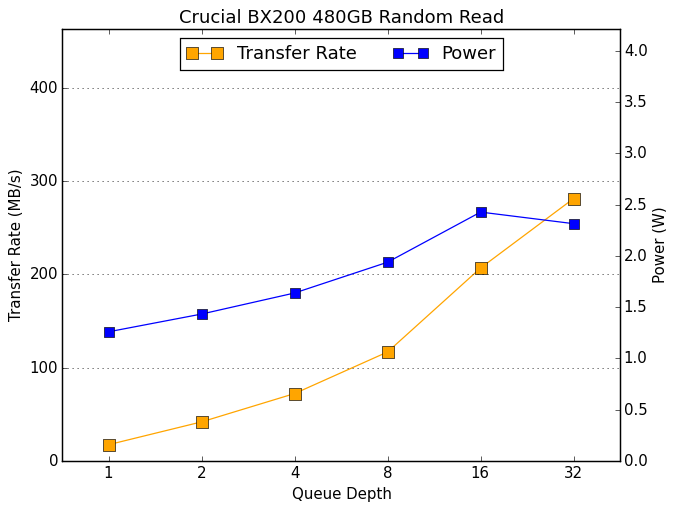 |
|||||||||
| Default | |||||||||
Performance scales smoothly as queue depth increases but it still starts low and never reaches very high.
Random Write Performance
The random write test is confined to a 16GB portion of the drive, which is otherwise empty and fresh from a secure erase. This gives the drive the chance to demonstrate much higher performance than on our performance consistency test that fills the drive. Tasks like installing software updates can modify a lot of files, but aren't hitting the entire disk. Random writes to the entire disk are usually found only in enterprise workloads such as large databases.
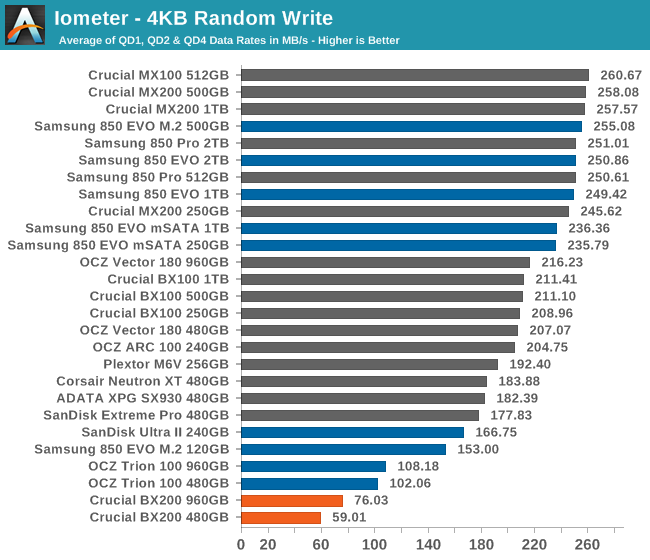
Our Iometer tests run for three minutes at each queue depth, so within 9 minutes the BX200 is clearly having trouble. The higher capacity of the the 960GB drive seems to help a lot, which suggests that the 240GB BX200's performance might be much worse than that of the 480GB.
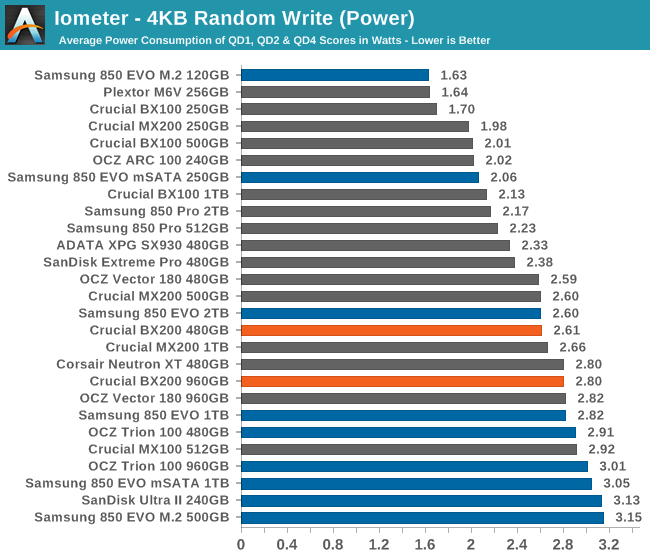
Power consumption is normal for a TLC drive, which suggests that there are a lot of background writes being done by the drive that are keeping power consumption up in spite of how little real work is getting done.
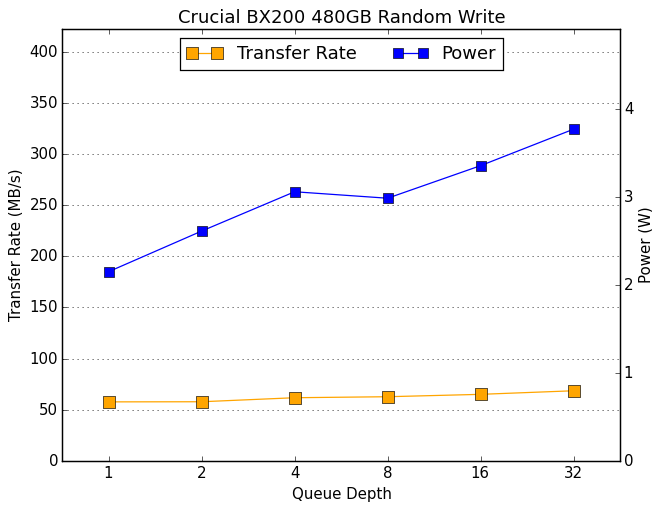 |
|||||||||
| Default | |||||||||
Random write performance hardly scales at all with increased queue depth, which is very uncommon but we have seen similar behavior from the OCZ Trion 100. Power consumption does increase dramatically, so the drive is clearly mismanaging the load of heavy writes.










85 Comments
View All Comments
paulgj - Monday, November 9, 2015 - link
I just ordered a couple more BX100's 250GBdoggface - Tuesday, November 3, 2015 - link
The MX100 was just brilliant, an easy recommendation.The BX100 has been my go to value SSD, that l I recommended to many friends. The bx200 is garbage which costs more? And is about as bad as a HDD. What the hell crucial. What the hell.Luke212 - Tuesday, November 3, 2015 - link
BX100 and MX100 were great.... how can they go backward so badly?JDG1980 - Tuesday, November 3, 2015 - link
It's looking more and more as though TLC is a big flop. It doesn't seem to provide substantial price savings, and it comes at a considerable cost in performance, durability, and reliability.For a TLC drive to be worth it, it would need to be 1/2 to 1/4 the cost per gigabyte of a MLC solution on the largest drives. It then might be acceptable for people who want moderately priced bulk storage that's cheaper than standard SSDs. But that's not close to being the case now, and it may never be.
CiccioB - Wednesday, November 4, 2015 - link
Yeah, I still wonder if TLC is really reliable as producers advertise them.Samsung needed a "hack" to their 840 TLC series to solve data retention problems reducing life time.
We do not know if others have done the same without (obviously) telling publicly. And if 850 series has it under the hood.
I would go to MLC drives for few $ more. I feel them as more reliable and durable. And "feeling" is an important thing for me, as I put my data on them and saving few bucks may not really be an advantage when a TLC drive lives less then a MLC one.
For performance, I bet anyone to be able to discern differences in real life form an SSD to another. This are "synthetic" tests, where source of data is faster than SSD speed (RAM). For whatever real usage, anything comes from sources that are slower (HDD, network, optical disks). Load times into RAM is limited, as you don't usually load GB and GB into it but during a benchmark.
What it really matters is reliability, durability and price. TLC fails to make me comfortable with the first two criteria. Which, for me, are the most important ones.
CiccioB - Wednesday, November 4, 2015 - link
"This are "synthetic" tests"These are synthetic tests.
Edit button, please!
extide - Thursday, November 5, 2015 - link
Yeah it seems like you really need to go to 3D NAND to get decent TLC -- the 850 EVO's have so far been pretty much great. That significantly larger feature size really helps the TLC out.Beaver M. - Wednesday, November 4, 2015 - link
No wonder I have been skipping reviews of new SATA SSDs for a few years now. Nothing can touch the Samsung ones, and thats sad.ghanz - Wednesday, November 4, 2015 - link
Review request: Please do a review of Sandisk Plus, their current lowest tier SSDs available in 120gb and 240gb capacities.Will be interesting to see how those compares to the BX100 and BX200 in similar capacities.
Mugur - Wednesday, November 4, 2015 - link
I must buy another BX100 until the stocks will dry...